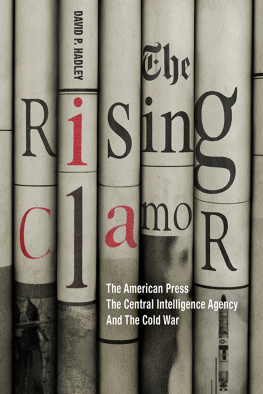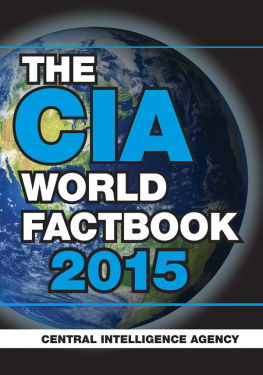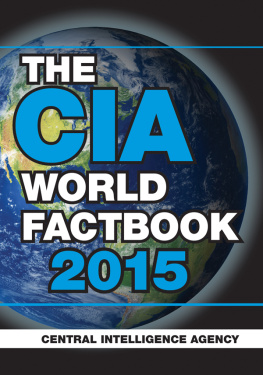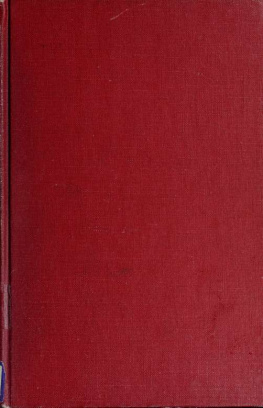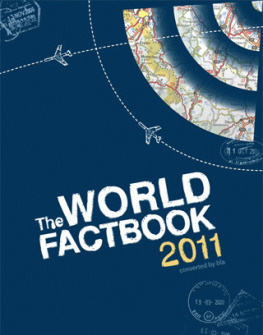Central Intelligence Agency - CIA World Factbook 2022-2023
Here you can read online Central Intelligence Agency - CIA World Factbook 2022-2023 full text of the book (entire story) in english for free. Download pdf and epub, get meaning, cover and reviews about this ebook. year: 2022, publisher: Skyhorse, genre: Politics. Description of the work, (preface) as well as reviews are available. Best literature library LitArk.com created for fans of good reading and offers a wide selection of genres:
Romance novel
Science fiction
Adventure
Detective
Science
History
Home and family
Prose
Art
Politics
Computer
Non-fiction
Religion
Business
Children
Humor
Choose a favorite category and find really read worthwhile books. Enjoy immersion in the world of imagination, feel the emotions of the characters or learn something new for yourself, make an fascinating discovery.
- Book:CIA World Factbook 2022-2023
- Author:
- Publisher:Skyhorse
- Genre:
- Year:2022
- Rating:5 / 5
- Favourites:Add to favourites
- Your mark:
- 100
- 1
- 2
- 3
- 4
- 5
CIA World Factbook 2022-2023: summary, description and annotation
We offer to read an annotation, description, summary or preface (depends on what the author of the book "CIA World Factbook 2022-2023" wrote himself). If you haven't found the necessary information about the book — write in the comments, we will try to find it.
CIA World Factbook 2022-2023 — read online for free the complete book (whole text) full work
Below is the text of the book, divided by pages. System saving the place of the last page read, allows you to conveniently read the book "CIA World Factbook 2022-2023" online for free, without having to search again every time where you left off. Put a bookmark, and you can go to the page where you finished reading at any time.
Font size:
Interval:
Bookmark:


Copyright 2022 by Skyhorse Publishing
All rights reserved. No part of this book may be reproduced in any manner without the express written consent of the publisher, except in the case of brief excerpts in critical reviews or articles. All inquiries should be addressed to Skyhorse Publishing, 306 West 37th Street, 11th Floor, New York, NY 10018.
Skyhorse Publishing books may be purchased in bulk at special discounts for sales promotion, corporate gifts, fund-raising, or educational purposes. Special editions can also be created to specifications. For details, contact the Special Sales Department, Skyhorse Publishing, 307 West 36th Street, 11th Floor, New York, NY 10018 or .
Skyhorse and Skyhorse Publishing are registered trademarks of Skyhorse Publishing, Inc., a Delaware corporation.
Visit our website at www.skyhorsepublishing.com.
10 9 8 7 6 5 4 3 2 1
Library of Congress Cataloging-in-Publication Data is available on file.
Cover design by Brian Peterson
Print ISBN: 978-1-5107-7118-5
Ebook ISBN: 978-1-5107-7119-2
Printed in the United States of America
INTRODUCTION
The World Factbook is prepared by the Central Intelligence Agency for the use of US Government officials, and the style, format, coverage, and content are designed to meet their specific requirements. Information is provided by Antarctic Information Program (National Science Foundation), Armed Forces Medical Intelligence Center (Department of Defense), Bureau of the Census (Department of Commerce), Bureau of Labor Statistics (Department of Labor), Central Intelligence Agency, Council of Managers of National Antarctic Programs, Defense Intelligence Agency (Department of Defense), Department of Energy, Department of State, Fish and Wildlife Service (Department of the Interior), Maritime Administration (Department of Transportation), National Geospatial-Intelligence Agency (Department of Defense), Naval Facilities Engineering Command (Department of Defense), Office of Insular Affairs (Department of the Interior), Office of Naval Intelligence (Department of Defense), US Board on Geographic Names (Department of the Interior), US Transportation Command (Department of Defense), United Nations Population Division (World Urbanization Prospects: The 2018 Revision and World Population Prospects: The 2019 Revision urbanization and population data used with permission), International Telecommunication Union, International Institute for Strategic Studies, Oil Gas Journal, and other public and private sources.
The Factbook is in the public domain. Accordingly, it may be copied freely without permission of the Central Intelligence Agency (CIA). The official seal of the CIA, however, may NOT be copied without permission as required by the CIA Act of 1949 (50 U.S.C. section 403m). Misuse of the official seal of the CIA could result in civil and criminal penalties.
Citation Model
The World Factbook 2021. Washington, DC: Central Intelligence Agency, 2021.
https://www.cia.gov/the-world-factbook/
Comments and queries are welcome and may be addressed to:
Central Intelligence Agency
Attn: Office of Public Affairs
Washington, DC 20505
A BRIEF HISTORY OF BASIC INTELLIGENCE AND THE WORLD FACTBOOK
The Intelligence Cycle is the process by which information is acquired, converted into intelligence, and made available to policymakers. Information is raw data from any source, data that may be fragmentary, contradictory, unreliable, ambiguous, deceptive, or wrong. Intelligence is information that has been collected, integrated, evaluated, analyzed, and interpreted. Finished intelligence is the final product of the Intelligence Cycle ready to be delivered to the policymaker.
The three types of finished intelligence are: basic, current, and estimative. Basic intelligence provides the fundamental and factual reference material on a country or issue. Current intelligence reports on new developments. Estimative intelligence judges probable outcomes. The three are mutually supportive: basic intelligence is the foundation on which the other two are constructed; current intelligence continually updates the inventory of knowledge; and estimative intelligence revises overall interpretations of country and issue prospects for guidance of basic and current intelligence. The World Factbook, The Presidents Daily Brief, and the National Intelligence Estimates are examples of the three types of finished intelligence.
The United States has carried on foreign intelligence activities since the days of George Washington but only since World War II have they been coordinated on a government-wide basis. Three programs have highlighted the development of coordinated basic intelligence since that time: (1) the Joint Army Navy Intelligence Studies (JANIS), (2) the National Intelligence Survey (NIS), and (3) The World Factbook.
During World War II, intelligence consumers realized that the production of basic intelligence by different components of the US Government resulted in a great duplication of effort and conflicting information. The Japanese attack on Pearl Harbor in 1941 brought home to leaders in Congress and the executive branch the need for integrating departmental reports to national policymakers. Detailed and coordinated information was needed not only on such major powers as Germany and Japan, but also on places of little previous interest. In the Pacific Theater, for example, the Navy and Marines had to launch amphibious operations against many islands about which information was unconfirmed or nonexistent. Intelligence authorities resolved that the United States should never again be caught unprepared.
In 1943, Gen. George B. Strong (G-2), Adm. H. C. Train (Office of Naval Intelligence ONI), and Gen. William J. Donovan (Director of the Office of Strategic Services OSS) decided that a joint effort should be initiated. A steering committee was appointed on 27 April 1943 that recommended the formation of a Joint Intelligence Study Publishing Board to assemble, edit, coordinate, and publish the Joint Army Navy Intelligence Studies (JANIS). JANIS was the first interdepartmental basic intelligence program to fulfill the needs of the US Government for an authoritative and coordinated appraisal of strategic basic intelligence. Between April 1943 and July 1947, the board published 34 JANIS studies. JANIS performed well in the war effort, and numerous letters of commendation were received, including a statement from Adm. Forrest Sherman, Chief of Staff, Pacific Ocean Areas, which said, JANIS has become the indispensable reference work for the shore-based planners.
The need for more comprehensive basic intelligence in the postwar world was well expressed in 1946 by George S. Pettee, a noted author on national security. He wrote in The Future of American Secret Intelligence (Infantry Journal Press, 1946, page 46) that world leadership in peace requires even more elaborate intelligence than in war. The conduct of peace involves all countries, all human activities not just the enemy and his war production.
The Central Intelligence Agency was established on 26 July 1947 and officially began operating on 18 September 1947. Effective 1 October 1947, the Director of Central Intelligence assumed operational responsibility for JANIS. On 13 January 1948, the National Security Council issued Intelligence Directive (NSCID) No. 3, which authorized the
Next pageFont size:
Interval:
Bookmark:
Similar books «CIA World Factbook 2022-2023»
Look at similar books to CIA World Factbook 2022-2023. We have selected literature similar in name and meaning in the hope of providing readers with more options to find new, interesting, not yet read works.
Discussion, reviews of the book CIA World Factbook 2022-2023 and just readers' own opinions. Leave your comments, write what you think about the work, its meaning or the main characters. Specify what exactly you liked and what you didn't like, and why you think so.






